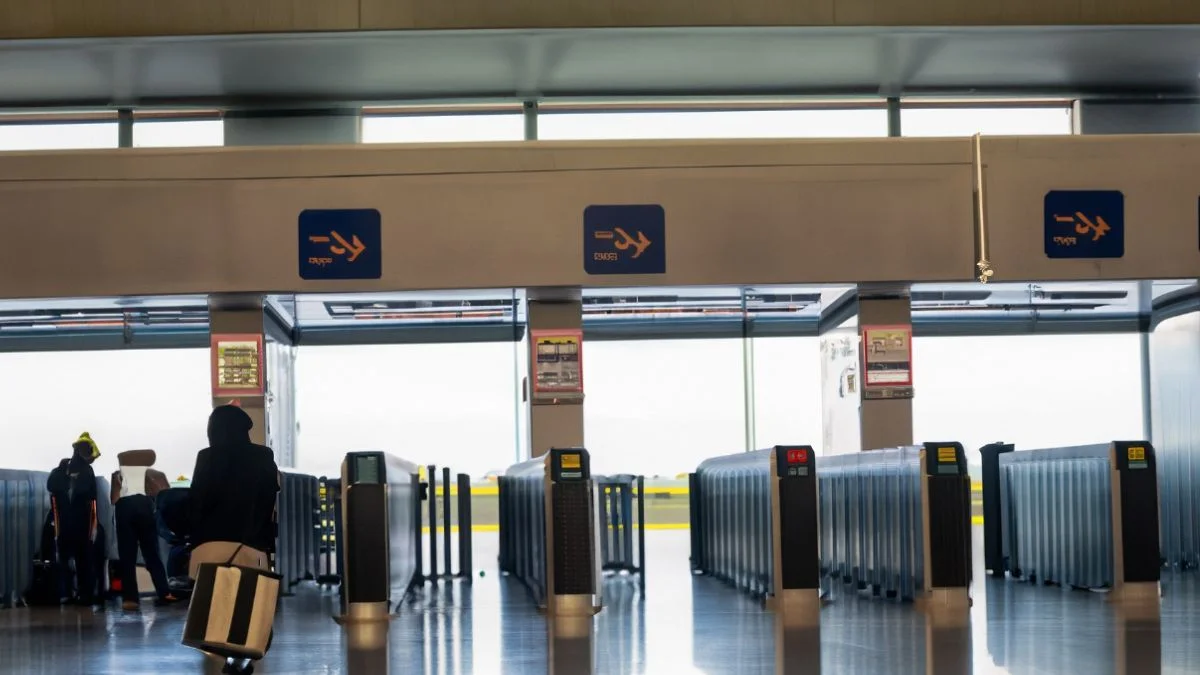Do You Go Through Customs When Leaving the US? Exploring International Departure Procedures

As participants in Amazon Associates and other programs, we earn from qualifying purchases. This comes at no additional cost to you. For more details, see our Affiliate Disclosure.
In a globalized world of instant connectivity, international travel has become an inevitable part of our lives. Yet, it is also a process often shrouded in questions and ambiguities. One such question that repeatedly boggles the minds of travelers leaving the United States is – do you go through customs when leaving the country? The answer isn’t as straightforward as it might seem.
In this article, we will delve deep into the topic, exploring and demystifying the international departure procedures from the US. Our discussion will provide insight into what to expect when you depart from an American airport to land in foreign territories, the key differences between customs and immigration, and the roles of each during your travel. So, let’s pack our proverbial bags and embark on a journey to understand the intricacies of customs procedures when leaving the United States.
Understanding the Basics: Customs Vs. Immigration
As you start planning your international journey, you’ll often come across the terms ‘Customs’ and ‘Immigration.’ These two entities play pivotal roles in the international travel process, but they serve different purposes. Understanding the distinction between them is crucial for a hassle-free journey.
Customs
The role of customs is to control the goods (and sometimes people) entering and leaving the country. This includes everything from the personal belongings you carry in your luggage to large scale import and export of goods.
The primary focus of customs authorities is to enforce trade laws and regulations, prevent smuggling and illegal goods transport, and collect import and export duties. When you travel internationally, you’ll typically interact with customs officers when you return to the US or enter a foreign country.
They may ask about the items you’re bringing into the country, verify if they’re permitted, and assess whether you owe any duty or taxes on them.
Immigration
Immigration, on the other hand, deals primarily with people rather than goods. The role of immigration officers is to control the movement of people into and out of the country. They check the legality of a person’s right to enter, stay, or work in a country, based on their nationality and purpose of visit.
When you leave the US, you may be required to go through an immigration officer who will check your passport, visa (if applicable), and other related documents. They verify your identity, ensure you have the legal right to travel, and have not overstayed your visa.
Decoding Departure: The International Exit Procedure from the US
While every airport may slightly vary in its procedures, departing from the United States generally follows a specific process. It’s important to note that the US, unlike several other countries, does not generally perform formal exit controls. Here’s a typical step-by-step guide to the international exit procedure:
1. Check-in and Ticketing:
The first step of your departure process will be to check-in for your flight. Depending on your airline, you may be able to do this online or at a self-service kiosk at the airport. However, for international flights, many airlines require passengers to check-in at the ticketing counter, especially if they’re checking bags.
2. Security Screening:
After checking in, you will proceed to the Transportation Security Administration (TSA) security checkpoint. Here, you will need to present your boarding pass and a valid form of identification (like a passport for international travel). Your luggage and personal items will also go through an X-ray machine for inspection. The TSA’s primary function is to ensure the safety and security of flights, so this step is focused on finding any prohibited items.
3. Waiting at the Departure Lounge:
Once you’ve passed through security, you’ll enter the departure area or concourse, where you’ll wait until your flight is ready to board. You can use this time to shop, dine, or relax.
4. Boarding:
When it’s time to board, you’ll need to present your boarding pass and passport. This process is managed by the airline, and at this stage, they are mainly verifying that you are the correct passenger for the flight.
5. In-flight:
Once on the plane, you might be given forms to fill out, such as a customs declaration or passenger locator form for your destination country.
6. Arrival at Destination:
Upon arrival in your destination country, you will go through their immigration and customs process, where you may need to present the forms you filled out during the flight.
So, as you can see, the exit procedure from the US focuses on ensuring the security of the flight (via TSA checks) and verifying passengers’ identities (via the airline’s boarding process). There is generally no formal exit immigration control or customs check for departing passengers. However, as we’ll see, there are some exceptions to this rule.
The Role of TSA in American Airports
The Transportation Security Administration, or TSA, is an agency of the U.S. Department of Homeland Security that was created in the wake of the September 11, 2001, terrorist attacks. Its primary mission is to ensure the security of travelers within the United States, particularly those traveling by air. Here’s how TSA plays a pivotal role in American airports.
Screening Process
The most apparent role of the TSA in airports is conducting security screenings of passengers and their luggage. Before boarding a flight, every traveler must go through a TSA checkpoint. This process involves presenting a valid boarding pass and a form of identification, going through a body scanner, and having carry-on luggage X-rayed.
TSA’s screening is designed to prevent prohibited items, such as weapons, explosives, and other threats, from making it onto an airplane. The list of prohibited items is extensive and includes items that are generally harmless outside of the context of an airplane.
Checked Luggage
In addition to screening passengers and their carry-on bags at security checkpoints, TSA also screens all checked luggage for explosives and other threats. This screening often involves the use of large X-ray machines or other scanning technology, and may sometimes include a physical search of the bag.
Secure Flight Program
The TSA is responsible for the Secure Flight program, which is designed to enhance the security of domestic and international commercial flights. As part of this program, airlines collect specific information from passengers (full name, date of birth, and gender) and transmit this data to TSA. TSA then matches this information against watch lists to identify any potential threats.
Security Measures
TSA is continually implementing and updating security measures in airports to respond to evolving threats. These measures range from introducing new screening technology and procedures to employing specially trained officers and canines.
While the TSA’s role is central to maintaining security, it doesn’t involve customs inspections or immigration checks. TSA focuses on ensuring the safety of your flight, rather than controlling who leaves the country or what they are taking with them. That’s where customs and immigration agencies come in, and as we’ve discussed earlier, in the US, there is generally no formal customs or immigration check when you leave the country.
Do You Go Through Customs When Leaving the US?
Contrary to the expectation of many first-time international travelers, the answer is usually no; you do not go through customs when leaving the United States. This lack of a customs check may seem odd to individuals who have traveled internationally from other countries where both exit and entry customs inspections are the norm.
In the U.S., customs primarily focuses on goods and people entering the country, ensuring that nothing illegal is brought in and that all necessary duties are paid on imported goods.
When you depart from the U.S., the standard procedure involves checking in with your airline, going through TSA security screening, and then boarding your flight. No customs officers are typically involved in this process.
The U.S. operates on a system called “advance passenger information,” where airlines send passenger information to the destination country ahead of the flight. Therefore, U.S. Customs and Border Protection (CBP) knows who is leaving the country without the need for a formal exit check.
However, in some cases, you might experience something akin to a customs check. For example, if you’re traveling with a large amount of currency (over $10,000), you’re required to report it to CBP before departure. Likewise, certain items, such as cultural artifacts or protected species, may need declaration and approval for export.
Why Customs Check Isn’t Standard During Departure in the US
The absence of customs checks when departing the United States may seem unusual, especially for those who have traveled abroad from other countries that perform routine exit customs inspections. However, there are several reasons why the U.S. has adopted this approach:
1. Emphasis on Entry Control:
The main focus of the U.S. Customs and Border Protection (CBP) is to regulate and facilitate international trade, collect import duties, and enforce U.S. regulations, including trade, customs, and immigration. Most of these tasks pertain to goods and individuals entering the country, rather than those leaving.
2. Resource Allocation:
Customs checks at the time of departure would require a significant investment in terms of personnel, infrastructure, and time. Given the vast number of people traveling internationally from the U.S., performing exit checks on all departing passengers would be a considerable logistical undertaking. The U.S. has chosen to invest its resources heavily in entry control, where they believe it is most needed.
3. Advance Passenger Information System:
The U.S. employs an Advance Passenger Information System (APIS), which requires airlines to provide passenger manifests before flights depart. This information gives law enforcement a chance to know who’s leaving the country without requiring a face-to-face check.
4. Effective Security Measures:
The U.S. places a great deal of emphasis on security. The Transportation Security Administration (TSA) carries out extensive checks to ensure the safety of flights. These checks focus on preventing threats (such as weapons or explosives) from being taken onto planes rather than checking for items being exported illegally.
5. Exit Immigration Checks Not Required:
Unlike some countries, the U.S. does not require exit visas or have regulations that necessitate checking the immigration status of all departing passengers.
While it might seem odd that the U.S. doesn’t perform exit customs checks, this practice is in line with their approach to border control and resource allocation. It is essential, however, to understand that this doesn’t mean there are no checks or controls on those leaving the U.S. – these checks just take a different form.
Situations When You Might Encounter Customs Before Departure
While the norm is that you won’t have a customs inspection when leaving the United States, there are certain situations where you might encounter a customs officer or have to adhere to customs regulations before departure. Here are a few examples:
1. Carrying Large Amounts of Currency:
If you’re traveling internationally with more than $10,000 in currency or negotiable monetary instruments (this includes coins, currency, traveler’s checks, and money orders), you are required by law to declare this to U.S. Customs and Border Protection (CBP) before your departure. Failure to do so can lead to the seizure of the money by CBP.
2. Exporting Certain Goods:
Certain goods are subject to export controls or may be prohibited from being exported altogether. These include firearms, certain types of technology, artifacts, and certain animal products. If you are traveling with any items that are subject to export restrictions, you may need to declare these to CBP and possibly obtain an export license.
3. Pre-Clearance Locations:
In some cases, you may go through U.S. customs before you even board your flight – but this is usually when you’re returning to the U.S., not when you’re leaving. The U.S. has pre-clearance locations at certain foreign airports.
At these locations, CBP officers are stationed to screen passengers and their belongings before they board flights to the U.S. This process involves both immigration and customs inspection, but it is done in the foreign country before departure.
4. CBP Spot Checks:
Although it is not standard practice, CBP officers might conduct random checks at departure gates for international flights. These checks are often focused on immigration matters but could also involve customs-related questions.
Remember, even though you generally won’t go through customs when leaving the U.S., it’s crucial to understand the regulations that apply to what you can legally take out of the country. Violating these rules can lead to penalties, including fines and seizure of goods.
Traveling Internationally: What to Expect on Arrival at Your Destination
While the United States may not have customs inspections on departure, this isn’t typically the case for your arrival in foreign countries. Here’s a general idea of what you can expect when you arrive at your international destination:
1. Immigration Check:
The first stop after you disembark from the plane will usually be immigration control. Here, an immigration officer will check your passport and, if required, your visa. They may also ask you questions about the purpose of your visit, how long you intend to stay, and where you’ll be staying. Some countries might even take your biometrics (like fingerprints or facial image) as part of their immigration process.
2. Customs Inspection:
After immigration, you’ll proceed to collect any checked luggage and then move on to customs. Different countries have different rules about what you can bring in, and you may be required to fill out a customs declaration form stating what you’re bringing into the country.
Typically, there are two channels to choose from: a green channel (nothing to declare) for travelers who believe they are not carrying any goods that need to be declared, and a red channel (goods to declare) for those carrying goods above the allowance or items that are prohibited or restricted.
If you choose the green channel and customs officers decide to check your bags, and they find something that should have been declared, you may face penalties.
3. Quarantine Inspection:
In some countries, there may be a separate quarantine inspection to prevent the entry of certain plants, animals, or food products that could introduce diseases or pests. This may be done as part of the customs process or separately.
4. Health Checks:
Depending on the current global health situation or specific country regulations, you may also be subjected to health screenings upon arrival. These checks could range from temperature screenings to health declaration forms, and even COVID-19 tests.
Keep in mind that the exact process and what is required will depend on the specific country you’re visiting. It’s always a good idea to research ahead of time to understand the regulations of your destination country, including what items are permitted or prohibited, what needs to be declared, and if there are any health-related requirements due to ongoing global pandemics.
A Look at the APIS and Its Importance in US Departures
The Advance Passenger Information System (APIS) is an electronic data interchange system established by U.S. Customs and Border Protection (CBP). It’s an integral part of modern international travel, especially in how the U.S. handles departures. Here’s a closer look at APIS and its importance:
What is APIS?
APIS is a system that collects basic biographical information from air and sea travelers before they depart for or arrive in the United States. The information generally includes details such as full name, date of birth, gender, country of citizenship, passport details, and travel itinerary.
Airlines and maritime carriers are required to collect this information from passengers and transmit it to CBP either shortly before a flight or sea voyage departs, or upon departure.
The Role of APIS in U.S. Departures
APIS plays a vital role in the security of the United States by providing CBP officers with pre-arrival and departure manifest data on all passengers and crew members.
Here’s how it impacts U.S. departures:
- Exit Tracking: While the U.S. doesn’t have formal exit controls for most travelers, APIS serves as a digital method of tracking who is leaving the country. This aids in maintaining immigration records and can help identify individuals who may have overstayed their visas.
- Security Checks: The information provided through APIS allows CBP to perform security checks on individuals before they depart the U.S., enhancing the safety and security of international flights.
- Law Enforcement: APIS data is used by various law enforcement agencies to track the movements of persons of interest.
Privacy and Data Protection
While APIS is a powerful tool for law enforcement and border protection, it also raises questions about privacy and data protection. CBP asserts that it follows stringent protocols to safeguard privacy and protect this data from unauthorized access. Furthermore, the use and retention of APIS data are governed by U.S. law.
Tips for a Smooth Exit: Preparing for Your International Departure from the US
Preparing for an international departure can feel a bit daunting, especially with all the different processes and procedures to keep in mind. However, with a bit of advance planning and understanding, your exit from the U.S. can be smooth sailing. Here are a few tips to help you prepare for your departure:
1. Check Passport and Visa Requirements:
Ensure your passport is valid for the duration of your trip. Some countries require that your passport be valid for six months beyond your planned departure date from the destination country. Also, check if your destination country requires a visa and apply for it well in advance if needed.
2. Know What You Can Take:
Understand the rules about what you can and cannot take out of the country, especially if you’re carrying large amounts of cash or goods that might be subject to export controls. If you’re unsure, check the U.S. Customs and Border Protection (CBP) website or consult with an expert.
3. Arrive Early:
International flights generally recommend arriving at the airport at least three hours before your flight. This allows plenty of time for check-in, security screening, and any unexpected delays.
4. Understand TSA Rules:
Make sure you know the Transportation Security Administration (TSA) rules regarding what items are allowed in your carry-on luggage and what must be checked. Be prepared for the security screening process: remove shoes, belts, jackets, and empty your pockets. Also, remember the liquid rule: containers must be 3.4 ounces (100ml) or smaller and fit in a single, quart-size, zip-top, clear plastic bag.
5. Fill out Any Necessary Forms:
Some airlines might provide you with necessary forms to fill out during the flight, such as a customs declaration or passenger locator form for your destination country. It’s easier to fill these out on the plane rather than waiting until you’ve landed.
6. Stay Informed:
Keep an eye on the current political and health situations in your destination country. This could impact not only your stay but also your entry into the country. If there’s a significant health concern, like a pandemic, there may be additional procedures in place for your arrival.
Remember, every trip and every traveler is unique, so these tips are general advice. Your preparations might vary depending on your circumstances and the specific requirements of your destination country. Safe travels!






